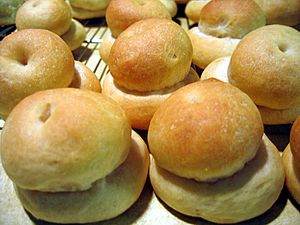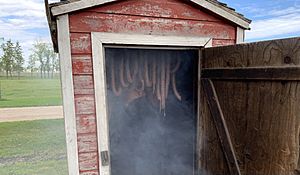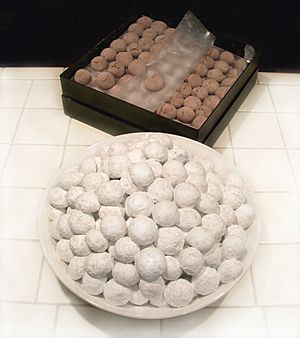Mennonite cuisine facts for kids
Mennonite cuisine is the special food often eaten by Mennonites, a Christian group that started in Europe way back in the 1500s. Because they faced tough times, many Mennonites moved to new places like North America, Prussia, and Russia. As they settled, they mixed their own traditions with the foods of the countries they lived in. This created unique dishes!
It's important to know that "Mennonite cuisine" mostly refers to the food of groups like the Russian Mennonites. Not all Mennonites around the world eat these specific foods today. Also, many of these dishes are similar to foods found in countries like Poland, Ukraine, and Russia, where Mennonites lived. Mennonites don't have special rules about what they can or can't eat, unlike some other religious groups. While some conservative Mennonites choose not to drink alcohol, others do.
Contents
Delicious Russian Mennonite Dishes

Russian Mennonite food is a mix of different cultures, especially Polish, Ukrainian, and Russian styles. Common ingredients you'll find in these dishes include cabbage, potatoes, sausage, and lots of dairy products like cheese.
One very famous food is Russian Mennonite zwieback. These are two-layered white buns that are roasted and dried. Zwieback can be stored for months, which made them perfect for long journeys when Mennonites moved from place to place.
Other popular Russian Mennonite foods include:
- Cottage cheese vereniki: These are like pierogi or dumplings, often filled with a creamy cottage cheese.
- Chicken soup: Often made with a special spice called star anise.
- Green bean soup: A hearty and comforting soup.
- Roll kuchen: A sweet, fried pastry that's a favorite treat.
- Plumemoos: A cold plum soup, perfect for a refreshing meal.
- Jreewe: These are crispy pork cracklings.
- Komst borscht: A tasty cabbage soup.
- Kjiekle: A type of noodle dish.
- Schmaunt fat: A rich, white cream gravy.
- Waffles: Often served with a sweet white vanilla sauce.
- New Year's Cookies: Sweet fried dumplings enjoyed during the holidays.
- Paska: A sweet bread often served at Easter.
- Mennonite farmer sausage: Also called formavorscht, this is a delicious smoked pork sausage.
Mennonite-style cheese is also well-known worldwide. For example, Queso Chihuahua or queso Chester are made by Mennonites in northern Mexico. In Manitoba, Canada, Bothwell Cheese is created by Mennonites there. Some Mennonites also brought yerba mate, a special tea, with them from Paraguay to Canada.
The Faspa Meal
Russian Mennonites often have a special late afternoon meal called faspa. This meal is usually simple and quick to prepare. It often includes zwieback, deli meat, raisin buns, pickles, and cheese, especially cheese curds. Faspa was a great way for farmers to get a mid-afternoon boost and for Mennonite women to have a rest, especially on Sundays.
Traditional Swiss Mennonite Foods
Swiss Mennonites moved to North America much earlier than the Russian Mennonites. Because of this, there are fewer specific dishes that are only linked to them or the Pennsylvania Dutch. However, some notable foods include:
- German beer sausage: A savory sausage.
- Schoofly pie: A unique type of pie.
- Apple fritters: Sweet, fried apple treats.
- Amish glazed donuts: Delicious glazed donuts.
Popular Mennonite Cookbooks
Many cookbooks have been created to save and share Swiss and Russian Mennonite recipes. These books help keep the food traditions alive for future generations.
One very popular book is The Mennonite Treasury of Recipes, often just called The Mennonite Treasury. It was first published in 1960 in Steinbach, Manitoba. This book helped make Russian Mennonite food famous and is one of the best-selling Mennonite books ever!
Other popular cookbooks include the "Mennonite Girls Can Cook" series, which also shares many Russian Mennonite dishes. The More-with-Less Cookbook is also found in many Mennonite kitchens. For Swiss-German Mennonite recipes, The Mennonite Community Cookbook by Mary Emma Showalter, first published in 1950, is a great resource.



